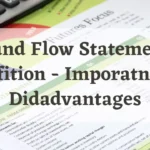Under the reducing balancing method, depreciation is charged at a fixed rate on the reducing balance of assets after deducting depreciation every year. The reducing method is also popularly known as Diminishing Balance Method. The balance in the asset account will go on decreasing but will never become zero.

The remaining balance in the asset account is taken as scrap value. This method is also called the diminishing balance, written down value, declining value, or book value method. The following points have to be taken into account while calculating the amount of depreciation on assets.
1. The annual rate of depreciation is fixed.
2. The annual amount of depreciation will decline every year as it is charged at a fixed rate on the declining balance of assets.
Written Down Value = Cost – Depreciation
3. If the rate of depreciation is got given in the question, the rate is determined by using the following formula
Rate of depreciation = 1-nroot scarp value/ Depreciable cost of assets
Advantages of the Diminishing Balance Method
The main advantages of reducing the balance method of depreciation are listed below.
- This method is easy to understand and simple to implement. Depreciation is calculated every year on the opening balance of assets.
- This method equalizes the yearly burden on profit and loss accounts in respect of both depreciation and repairs. The amount of depreciation goes on decreasing while the expenses on repairs go on increasing so that the total charge against revenue over different years remains more or less the same.
- This method is acceptable for income tax purposes.
- This method matches the cost and revenue of the business. The greater amount of depreciation provided in the initial years is matched against the higher amount of revenue generated by increased production by the use of a new asset.
Disadvantages of the Diminishing Balance Method
The main demerits of this method are as follows.
- The method charges a heavy amount of depreciation in earlier years.
- This formula to obtain the rate of depreciation can be applied only when there is a residual value of the asset.
Diminishing Balance Method Examples
Let’s say that you want to purchase a car that costs $20,000. You have decided to take out a loan to pay for it, and you have been approved for a loan at an interest rate of 10% per year, to be paid back over a period of 4 years.
Using the Diminishing Balance Method, you would calculate the interest on the outstanding balance of the loan at the end of each year. Here’s how the calculations would look:
Year 1:
Starting Balance: $20,000
Interest for the year: $2,000 (10% of $20,000)
Payment for the year: $6,000
Ending Balance: $16,000 ($20,000 – $6,000)
Year 2:
Starting Balance: $16,000
Interest for the year: $1,600 (10% of $16,000)
Payment for the year: $6,000
Ending Balance: $11,600 ($16,000 – $6,000)
Year 3:
Starting Balance: $11,600
Interest for the year: $1,160 (10% of $11,600)
Payment for the year: $6,000
Ending Balance: $6,760 ($11,600 – $6,000)
Year 4:
Starting Balance: $6,760
Interest for the year: $676 (10% of $6,760)
Payment for the year: $6,760
Ending Balance: $0 ($6,760 – $6,760)
As you can see, the interest charged decreases each year as the outstanding balance of the loan decreases. This is the basic idea behind the Diminishing Balance Method.
An important topic for you




